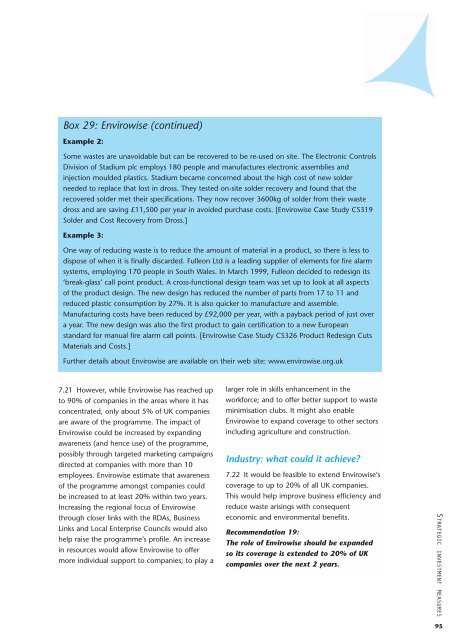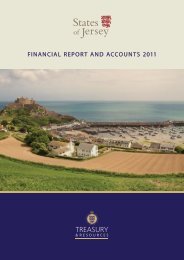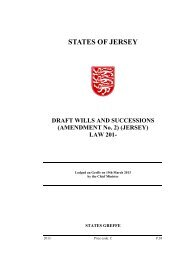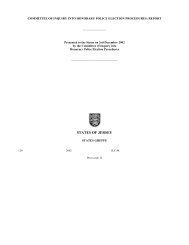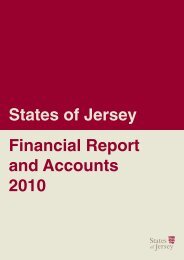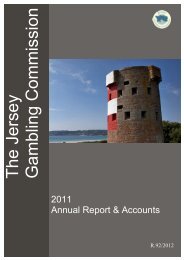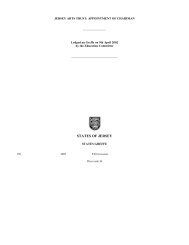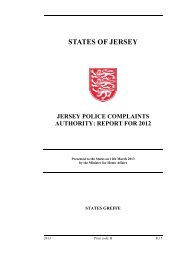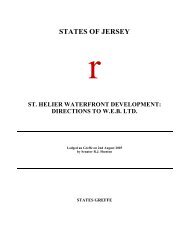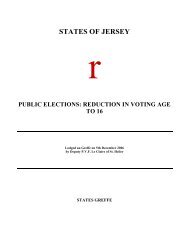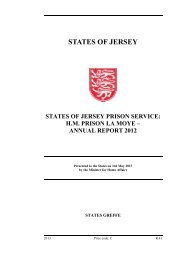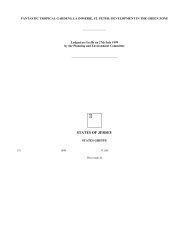Waste not want not - States Assembly
Waste not want not - States Assembly
Waste not want not - States Assembly
You also want an ePaper? Increase the reach of your titles
YUMPU automatically turns print PDFs into web optimized ePapers that Google loves.
Box 29: Envirowise (continued)<br />
Example 2:<br />
Some wastes are unavoidable but can be recovered to be re-used on site. The Electronic Controls<br />
Division of Stadium plc employs 180 people and manufactures electronic assemblies and<br />
injection moulded plastics. Stadium became concerned about the high cost of new solder<br />
needed to replace that lost in dross. They tested on-site solder recovery and found that the<br />
recovered solder met their specifications. They now recover 3600kg of solder from their waste<br />
dross and are saving £11,500 per year in avoided purchase costs. [Envirowise Case Study CS319<br />
Solder and Cost Recovery from Dross.]<br />
Example 3:<br />
One way of reducing waste is to reduce the amount of material in a product, so there is less to<br />
dispose of when it is finally discarded. Fulleon Ltd is a leading supplier of elements for fire alarm<br />
systems, employing 170 people in South Wales. In March 1999, Fulleon decided to redesign its<br />
‘break-glass’ call point product. A cross-functional design team was set up to look at all aspects<br />
of the product design. The new design has reduced the number of parts from 17 to 11 and<br />
reduced plastic consumption by 27%. It is also quicker to manufacture and assemble.<br />
Manufacturing costs have been reduced by £92,000 per year, with a payback period of just over<br />
a year. The new design was also the first product to gain certification to a new European<br />
standard for manual fire alarm call points. [Envirowise Case Study CS326 Product Redesign Cuts<br />
Materials and Costs.]<br />
Further details about Envirowise are available on their web site: www.envirowise.org.uk<br />
7.21 However, while Envirowise has reached up<br />
to 90% of companies in the areas where it has<br />
concentrated, only about 5% of UK companies<br />
are aware of the programme. The impact of<br />
Envirowise could be increased by expanding<br />
awareness (and hence use) of the programme,<br />
possibly through targeted marketing campaigns<br />
directed at companies with more than 10<br />
employees. Envirowise estimate that awareness<br />
of the programme amongst companies could<br />
be increased to at least 20% within two years.<br />
Increasing the regional focus of Envirowise<br />
through closer links with the RDAs, Business<br />
Links and Local Enterprise Councils would also<br />
help raise the programme’s profile. An increase<br />
in resources would allow Envirowise to offer<br />
more individual support to companies; to play a<br />
larger role in skills enhancement in the<br />
workforce; and to offer better support to waste<br />
minimisation clubs. It might also enable<br />
Envirowise to expand coverage to other sectors<br />
including agriculture and construction.<br />
Industry: what could it achieve?<br />
7.22 It would be feasible to extend Envirowise’s<br />
coverage to up to 20% of all UK companies.<br />
This would help improve business efficiency and<br />
reduce waste arisings with consequent<br />
economic and environmental benefits.<br />
Recommendation 19:<br />
The role of Envirowise should be expanded<br />
so its coverage is extended to 20% of UK<br />
companies over the next 2 years.<br />
STRATEGIC INVESTMENT MEASURES<br />
95


